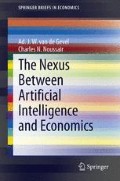Abstract
We review recent developments in artificial intelligence and relate them to economics. Artificial intelligence represents the technology most likely to lead to a singularity, an infinite rate of innovation and productivity growth. This could occur via dramatic increases in life expectancy, the development of whole brain emulation, and innovations in robotics. We argue that there is no reason to believe that artificial intelligence would increase human happiness. We describe some recent development in agent-based modeling in economics, which can be interpreted as the introduction of artificially intelligent agents into economics. We argue that classical economic theory, which assumes that all agents are rational and have infinite computational ability, is very relevant in describing the behavior of future artificially intelligent entities. Economic implications of accelerating innovation, greater longevity, and the introduction of robot labor are considered.
Access this chapter
Tax calculation will be finalised at checkout
Purchases are for personal use only
Notes
- 1.
Augusta Ada King, Countess of Lovelace (1815–1852) is sometimes considered the World's First Computer Programmer. She was the only legitimate child of the poet Lord Byron. She foresaw the capability of computers to go beyond mere calculating or number-crunching.
- 2.
The Three Laws of Robotics are:
-
Law 1. A robot may not injure a human being, or, through inaction, allow a human being to come to harm;
-
Law 2. A robot must obey the orders given to it by human beings except where such orders would conflict with the First Law;
-
Law 3. A robot must protect its own existence as long as such protection does not conflict with the First or Second Law.
-
- 3.
In the future, when robots really look and act like humans they might be referred to as “who”, rather than “which”.
- 4.
Swampman is the subject of a thought experiment introduced by Donald Davidson, in his 1987 paper "Knowing One's Own Mind". The experiment runs as follows: Suppose Davidson goes hiking in the swamp and is struck and killed during a storm by a lightning bolt. At the same time, nearby in the swamp another lightning bolt spontaneously rearranges a bunch of molecules such that, entirely by coincidence, they take on exactly the same form that Davidson's body had at the moment of his untimely death. This copy, whom Davidson terms 'Swampman', has a brain which is identical to that which Davidson had, and will thus, presumably, behave exactly as Davidson would have. He will walk out of the swamp, return to Davidson's office and write the same essays he would have written; he will interact like an amicable person with all of Davidson's friends and family, and so forth. But Davidson holds that there would nevertheless be a difference, though no one would notice it. Swampman will appear to recognize Davidson's friends, but actually he will not recognize them, as he has never seen them before.
- 5.
Prokaryotes are organisms that lack a cell nucleus or a membrane-bound kernel. Everything is openly accessible within the cell so that the DNA is not collected together in the area the membrane encloses. Eukaryotes are organisms whose cells contain complex structures enclosed within membranes which contain their DNA.
Author information
Authors and Affiliations
Corresponding author
Rights and permissions
Copyright information
© 2013 The Author(s)
About this chapter
Cite this chapter
van de Gevel, A.J.W., Noussair, C.N. (2013). The Nexus Between Artificial Intelligence and Economics. In: The Nexus between Artificial Intelligence and Economics. SpringerBriefs in Economics. Springer, Berlin, Heidelberg. https://doi.org/10.1007/978-3-642-33648-5_1
Download citation
DOI: https://doi.org/10.1007/978-3-642-33648-5_1
Published:
Publisher Name: Springer, Berlin, Heidelberg
Print ISBN: 978-3-642-33647-8
Online ISBN: 978-3-642-33648-5
eBook Packages: Business and EconomicsEconomics and Finance (R0)

